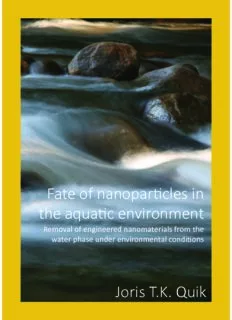
Fate of nanoparticles in the aquatic environment Joris TK Quik PDF
Preview Fate of nanoparticles in the aquatic environment Joris TK Quik
Fate of nanoparticles in the aquatic environment Removal of engineered nanomaterials from the water phase under environmental conditions Joris T.K. Quik Fate of nanoparticles in the aquatic environment Removal of engineered nanomaterials from the water phase under environmental conditions Joris T.K. Quik Quik JTK (2013) Fate of nanoparticles in the aquatic environment. Removal of engineered nanomaterials from the water phase under environmental conditions. PhD thesis, Radboud University Nijmegen, The Netherlands © 2013 Joris Quik, all rights reserved. ISBN: 978‐90‐6464‐692‐8 Fate of nanoparticles in the aquatic environment Removal of engineered nanomaterials from the water phase under environmental conditions Proefschrift ter verkrijging van de graad van doctor aan de Radboud Universiteit Nijmegen op gezag van de rector magnificus prof. mr. S.C.J.J. Kortmann, volgens besluit van het college van decanen in het openbaar te verdedigen op maandag 23 september 2013 om 12.30 uur precies door Joris Theodoor Kamal Quik geboren op 22 juli 1982 te Knokke‐Heist, België Promotoren: Prof. dr. ir. D. van de Meent Prof. dr. ir. A.J. Hendriks Manuscriptcommissie: Prof. dr. A.M.J. Ragas (voorzitter) Prof. dr. M. Cohen Stuart (Wageningen Universiteit) Prof. dr. ir. W.J.G.M. Peijnenburg (Universiteit Leiden) This research was financially supported by the National Institute for Public Health and the Environment (RIVM, SOR‐S340030), and by the EU FP6 project NanoInteract (NMP4‐CT‐2006‐033231). “The earth is but one country and mankind its citizens.” — Bahá’u’lláh Contents: Abbreviations 1 Chapter 1 General Introduction 3 Chapter 2 How to assess exposure of aquatic organisms to engineered 9 nanomaterials? Chapter 3 Effect of dissolved organic matter on cerium dioxide 35 nanoparticles settling in model fresh water Chapter 4 Natural colloids are the dominant factor in the 47 sedimentation of nanoparticles Chapter 5 Nanomaterials in naturalwaters: sedimentation rates and 57 attachment efficiencies for heteroaggregation Chapter 6 Rapid settling of nanoparticles due to heteroaggregation 77 with suspended sediment Chapter 7 Empirical versus mechanistic modeling of engineered 91 nanomaterial aggregation and sedimentation in water Chapter 8 Synthesis 103 Appendices 107 A: Supporting information to chapter 2 108 B: Supporting information to chapter 3 110 C: Supporting information to chapter 4 117 D: Supporting information to chapter 5 121 E: Estimating the attachment efficiency for 127 heteroaggregation of nanoparticles and natural colloids from sedimentation experiments F: Supporting information to chapter 6 136 Literature 143 Summary 157 Samenvatting 161 Dankwoord 165 Curriculum vitae and list of publications 169 Abbreviations List of most common abbreviations used in this thesis. AA Brabantse Aa(small stream) B‐DOM Bihain Dissolved Organic Matter CNT Carbon Nanotubes DLS Dynamic Light Scattering DLVO Derjaguin‐Landau‐Verwey‐Overbeek DOC Dissolved Organic Carbon DOM Dissolved Organic Matter EC Electric Conductivity ENM Engineered Nanomaterials ICP‐MS Inductively Coupled Plasma Mass Spectroscopy IJ IJsselmeer (lake) KG Karregat (small pond) MS Nieuwe Waterweg near Maassluis (brackish) MWCNT Multiwalled Carbon Nanotubes NC Natural Colloid nC Fullerene Nanoparticles 60 nm Nanometer (10‐9 meter) NP Nanoparticle NTA Nanoparticle Tracking Analysis NZ Noordzee (North Sea) PEC Predicted Environmental Concentration PNEC Predicted No‐Effect Concentration PSD Particle Size Distribution PVP Polyvinylpyrrolidone RL Rhine (river) SR‐DOM Suwannee River Dissolved Organic Matter SS Suspended Sediment TEM Transmission Electron Microscopy 1 Chapter 1 General introduction 3 Chapter 1 1.1 Engineered nanomaterials and nanotechnology Nanotechnology refers to the manipulation of materials at the nanoscale. The possibilities of this research field where envisioned by Richard Feynman in a famous talk in 1959.1 Later, between 1981 and 1992 the term nanotechnology was popularized and the scanning tunneling microscope and the atomic force microscope became well established leading to the research field we know today.2 Yet the field of nanotechnology continues to grow with increased application of nanomaterials in consumer products.3, 4 The main reason that materials at the nano‐scale are of specific interest are the changes in physico‐chemical properties which are different at the nano‐scale compared to the bulk material. These changes are mostly related to the increase in surface area to volume ratio, resulting in changes in physico‐chemical properties related to color,5 solubility,6 conductivity7 and catalytic activity8 of engineered nanomaterials (ENMs). Increasing quantities of materials at this small size are being produced.9 Although nanomaterials have many benefits10 the implications of large quantities of these types of materials entering the environment has not been fully understood.11‐16 While this is generally the case when novel chemicals are developed, the question remains whether current guidelines for risk assessment of novel chemicals, such as implemented in the Registration, Evaluation, Authorisation and Restriction of Chemical substances (REACH),17 are adequate for ENMs. Risk assessment of chemicals is based on both exposure and effect assessment.18 The exposure assessment is based on a good understanding of the environmental behavior of chemicals combined with quantification of the fate processes using modeling tools. Using such tools, the predicted exposure concentrations are estimated from the physico‐chemical characteristics of the aquatic system and chemical in question. The current methods used for exposure assessment are based on the physico‐chemical behavior of the dissolved form of a chemical. For this reason we need to investigate the applicability of these methods for ENMs because it is likely that the inherent particulate nature of ENMs demands a novel approach to exposure assessment of these materials.19 In order to adapt or develop new exposure assessment methods we need to fully understand the fate of ENMs in the natural environment and we should be able to derive quantitative descriptions of the relevant fate processes. There have been several definitions of nanomaterials with the most discussed being the recent recommendation by the EU.20 This recommendation classified nanomaterials as a new chemical group, defined by its external dimensions between 1 4
Description: